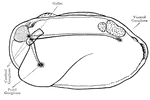Clipart tagged: ‘nervous system’

Arteries and Nerves
"Superficial arteries and nerves of the face and neck. 1, Temporal artery; 2, artery behind the ear;…

Hand Nerves
"Nerves of the had. 1, Nerves of the skin; 2, tendons; 3, arteries of the palm of the hand; 4, elbow…

Nerve Fibers
Nerve fibers. Labels: a, nerve-fiber, showing complete interruption of the white substance; b, another…
Nerve Ganglia (Spinal)
Nerve Ganglia, or Knots (sing. Ganglion; Knot) occur as collections of nerve cells on the course of…

Diagram of the Human Nervous System
Diagram illustrating the general arrangement of the cerebrospinal nervous system.

Nervous System Diagram
Diagram of nervous system. Labels: a, a, cortex of cerebral hemispheres; b, b, cell body and dendrites…

Diagram of a Neuron
Diagram of a neuron. Labels: A, axon arising from the cell-body and branching at its termination; D,…

Axial Skeleton
"Ideal plan of the double-ringed body of a vertebrate. N, neural canal; H, haemal canal; the body separating…



